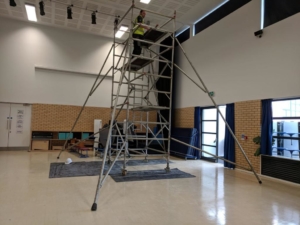The Benefits of Commercial LED Lighting
Are you looking for a way to cut costs on your commercial lighting? Commercial LED lighting is an energy-efficient and cost-effective solution that can save you money in the long run. This guide covers all of the key benefits, as well as information about installation and maintenance, to help you transition to LED lighting.
How LEDs Reduce Long-Term Costs
Commercial LED lighting may require a larger upfront cost than other traditional commercial light sources, but it pays off in the long run. LEDs have a significantly longer life span than regular commercial lighting and are more energy-efficient, which can save you money on labour costs and energy bills. Furthermore, reduced maintenance costs and fewer replacements means your overall costs will be lower in the long-term.
Improved Light Quality and Efficiency
Commercial LED lighting is known for its higher light quality and greater efficiency. It gives off an even light output, eliminating any dark spots or glare, while consuming only a fraction of the energy that traditional lighting requires. This improved light quality benefits employees, customers, and other building occupants by providing a healthier, more natural-looking light in spaces. As a result, many commercial buildings are switching to LEDs for improved energy efficiency and better illumination.
Reduced Heat Output
In addition to increased efficiency, LEDs also produce significantly less heat than traditional lighting options. By emitting nearly none of their energy as heat, the fixture’s operating temperature is significantly lower and requires far less cooling. As a result, buildings can save money on air conditioning and reduce their overall energy usage. Commercial LED lighting fixtures are designed with all-weather durability, meaning they stand up to extreme temperatures and other environmental factors much better than traditional alternatives. Furthermore, LEDs operate in places where warm-up times are critical due to their consistent output.
Versatility for Room Designs
LED lighting can be used to achieve different lighting levels, hues, and even colour temperatures. Different combinations allow for indoor lighting to be highly customized based on the needs of each room. LEDs also produce brilliant whites in addition to traditional incandescent colours, allowing you to enhance your lighting performance with an array of décor options. Commercial LED lights come in a variety of sizes and shapes for different applications. Whether mounted or suspended, placed along walls or flooring, chances are you will find an ideal product to fit your needs.
Reduced Maintenance Necessary
Unlike traditional bulbs, LED lighting requires minimal maintenance. Because PCB technology is designed to last far longer than other forms of lighting, they require much less frequent replacements – saving you time and money. There’s never a need to replace individual broken parts because the LEDs are mounted directly onto the fixture and easily interchangeable if needed.
Commercial Lighting Designs and Layouts
When it comes to commercial LED lighting, the initial investment may seem costly. However, with the right design, you can achieve a lighting system that is energy efficient and low maintenance. The proper illumination in an office or workspace not only helps improve productivity but also provides a pleasant atmosphere for employees. A qualified lighting designer can help ensure you get the most out of your LED lighting installation without sacrificing quality and long-term savings.
For commercial buildings, LED lighting is an efficient and modern way to ensure a productive atmosphere. It offers superior illumination over traditional lighting sources and can be used to design lighting plans that make use of lux levels established for optimal wellbeing. LEDs have the ability to be dimmed or brightened as needed, ensuring the precise amount of light for a task at hand. Additionally, LED lighting produces little to no heat so it does not interfere with other climate control systems in the building, making it an ideal choice for commercial spaces.
Commercial LED Lighting Installation
When it comes to commercial LED lighting, proper illumination is essential for the task force’s best productivity. To that end, professionals use the IESNA Lighting Handbook as a guide to making the ideal choices. The handbook covers specific topics such as under-lighting and over-lighting, providing critical guidance to designers setting out to light any commercial space.
Commercial LED lighting is a modern form of illumination where LEDs are used to provide light. In order to understand how much brightness is needed for a particular area, the foot candle (FC) or lux unit of illuminance measurement can be used. 1FC is equivalent to the amount of light cast on 1 square foot of a surface with 1 lumen from 1ft away. For example, 10lux would equal around 400lux which would be suitable illumination for an office environment. For more technical information, refer to the handbook regarding the number of FCs required for different spaces.
Commercial LED Lighting Considerations
When considering commercial LED lighting, Lighting Power Density (LPD) is an important factor. LPD is the range of lighting used per unit area and is measured in watts per square foot according to standards set in the IESNA lighting handbook. By accurately calculating LPD, clients can make informed decisions about their energy consumption and choose lower LPD estimates.
When looking for commercial LED lighting, kelvins and temperature play an important role in determining the right setup. The colour temperature is measured in units of kelvin (K) and generally falls into two categories: warm white light (2700-3000 K) which provides a cosy ambiance, perfect for restaurants and hotels; or cool white light (4000-6000 K) which is bright and often used in offices.
Commercial LED lighting that is set to a colour temperature of 3500K provides a neutral white, inviting light that creates an atmosphere of balance and alertness, making it ideal for office spaces.
Which Commercial LED Lighting is best for you?
Commercial LED lighting is a great option for businesses that need a focused and clear light. The 4100k cool white colour used in these lights provides a focused, clean atmosphere ideal for activities where the subject needs to be seen clearly. Common places that use this type of lighting include garages, grocery stores, and other commercial settings.
Commercial LED lighting in an effective, efficient and environment-friendly lighting solution for professional spaces. Its 5000k brilliant white light brings vibrancy to a variety of places, such as warehouses, hospitals, and sports stadiums. The accuracy and precision of this type of lighting makes it the ideal choice for businesses looking to optimize their space.
Commercial LED Lighting (Spacing)
When setting up commercial LED lighting, it is important to consider the correct spacing and layout of the light poles. As a general rule, space your poles 2.5 to 3 times their actual height apart from each other. This spacing will decrease if your poles are short in height. Most commercial light poles are made from aluminium 6063-76, have a wall thickness of 0.156 inches and measure to a total of 20ft in mounting height with a 4-5 inch square base that can be tapered down to 6 inches with a 4.5 inch diameter at the top.
LED Lighting for external use
Commercial LED lighting is a suitable choice for outdoor purposes. A range of light poles is available, with sizes ranging from 10ft to 100ft tall and the right fixtures can be attached depending on the illumination needs. Moreover, additional features such as timers, photocells, motion sensors and other controls are integrated to ensure maximum efficiency while minimizing light pollution. The directional lighting related to spacing must also be taken into consideration.
Commercial LED Lighting Summary
When shopping for commercial LED lighting, it is important to consider the purpose of the space, what type of lighting layout and lumens would be appropriate, and if the area is situated indoors or outdoors. By doing so, one will be able to make an informed decision as to which design will address their particular needs. For further assistance, contact our highly experienced sales team for a site survey and solution.
For further articles follow this link




